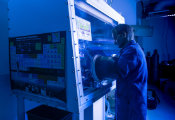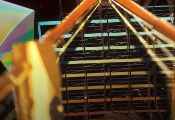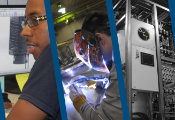An Architecture for Quantum Computers Based on Semiconductor Spin Qubits
Innsbruck and Aachen, 19 March 2024 – A group of physicists from ARQUE Systems and ParityQC present a version of the ParityQC Architecture specifically for quantum computers based on sparse grids of spin qubits. This quantum computing architecture represents an important step forward for the advancement of spin qubits as a quantum computing platform, efficiently harnessing their advantages such as fast timescales and small size. This invention has been outlined in the paper “Scalable Parity Architecture With a Shuttling-Based Spin Qubit Processor”, out now on arXiv as a pre-print.
ARQUE Systems and ParityQC have recently collaborated to develop an efficient quantum computing architecture specific for quantum computers based on spin qubits. In the pre-print “Scalable Parity Architecture With a Shuttling-Based Spin Qubit Processor”, the authors (Florian Ginzel, Michael Fellner, Christian Ertler, Lars R. Schreiber, Hendrik Bluhm and Wolfgang Lechner) present the results of this joint research: a novel implementation of the ParityQC Architecture for semiconductor spin qubits.
Among the several physical platforms for quantum computing that are currently being investigated worldwide, one platform that has emerged is semiconductor spin qubits in gate-defined quantum dots (QDs). ARQUE Systems, a spin-off of Forschungszentrum Jülich and RWTH Aachen University, is currently developing and commercializing quantum devices based on this promising platform. Spin qubits possess several important qualities that make them a promising platform for quantum computing: they have long coherence times, very fast gate times, a small size and a high scalability potential. In addition, the fabrication of quantum computers based on spin qubits could be relatively easy, making use of the sophisticated manufacturing capabilities of the semiconductor industry. However, as with all quantum computing platforms, there are also specific challenges to overcome, including for example environmental electric noise and cross-talk among qubits.
These challenges represented the starting point for the collaboration between ARQUE Systems and the quantum architecture company ParityQC. A group of physicists from the two companies engaged in joint research, with the aim of developing architectures that advance the use of spin qubits for quantum computing while harnessing their unique advantages. The proposal successfully combines ARQUE’s unique approach to spin shuttling (coherently moving the qubits in the chip on demand) with the ParityQC framework for solving optimization problems on quantum computers.
The paper explores the implementation and performance of the Parity Quantum Approximate Optimization Algorithm – QAOA (a gate-based algorithm for solving combinatorial optimization problems on a digital quantum computer) on two different architectures: a sparse spin bus architecture and a modular architecture with minimal registers. The authors develop gate sequences and an error model for each architecture and proceed to compare the performances. Realistic errors were considered, and it was found that both architectures can complete one round of Parity QAOA with a low single-qubit error probability, with the spin bus architecture slightly outperforming the modular architecture. The physical errors of both architectures were found to be low enough to decode the final state with a high success probability, implying that the architecture has an intrinsic potential for quantum error mitigation.
Overall, the findings in the paper represent a substantial step forward in the development of scalable architectures for quantum computing using spin qubits, a field that has been relatively unexplored in current literature. The research topic will continue to be explored in the ongoing collaboration between ARQUE Systems and ParityQC, two spin-offs that combine a strong background in fundamental research with its practical development and commercialization.




































